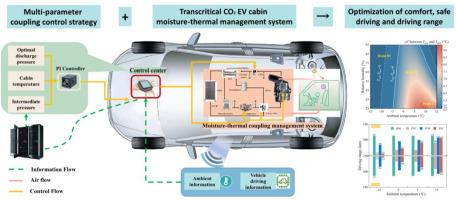基于跨临界CO2循环的电动汽车高级客舱湿热耦合管理控制策略综合性能分析
IF 17
1区 工程技术
Q1 ENERGY & FUELS
引用次数: 0
摘要
开发先进的客舱湿热耦合管理系统及其运行动态控制策略,对于保证电动汽车的乘坐舒适性、驾驶安全性和续驶里程至关重要。基于跨临界CO2循环,提出了独立热管理(ITM)系统和单级节流(SST)和双级节流(DST)两种湿热耦合管理系统。首先,建立了防雾评价标准,并在冬季运行条件下确定了不同控制区域。随后,对热力学特性进行了分析,发现海温湿热耦合管理循环具有最佳排放压力,可将功耗和舱内湿度降至最低。相比之下,夏令时周期的舱室湿度由中间压力调节,中间压力有上下限。最优排气压力随环境温度的升高而增大,最小中间压力随环境温度的升高而减小。此外,还对两种湿热耦合管理循环的性能进行了比较。从水分管理角度看,海温循环的抽湿率和比抽湿率分别显著提高了7倍和12.5倍。然而,夏令时周期的COP更优越。考虑到乘客舒适度和驾驶安全优先于能源效率,SST循环被认为是更合适的选择。最后,利用WLTC研究了海温周期的动态响应特性。此外,还分析了SST循环对行驶里程的影响。与ITM循环相比,SST循环的冬季行驶里程略低,但与传统的PTC热管理系统相比,其行驶里程增加了约5.17%。该研究为电动汽车高效座舱能量管理系统的动态特性提供了有价值的见解,并为冬季驾驶时的多目标耦合控制提供了一种新的方法。本文章由计算机程序翻译,如有差异,请以英文原文为准。

Comprehensive performance analysis of electric vehicle advanced cabin moisture-thermal coupling management control strategies based on transcritical CO2 cycle
The development of an advanced cabin moisture-thermal coupling management system, along with its operation dynamic control strategy, is essential for ensuring passenger comfort, driving safety, and the driving range of electric vehicles. Based on the transcritical CO2 cycle, an independent thermal management (ITM) system and two (the single-stage throttling (SST) and double-stage throttling (DST)) moisture-thermal coupling management systems are proposed. First, an anti-fog evaluation standard is established, and regions with different controls are defined across the winter operating conditions. Subsequently, the thermodynamic characteristics are analyzed, the SST moisture-thermal coupling management cycle features an optimal discharge pressure that minimizes both power consumption and cabin humidity. In contrast, the cabin humidity in the DST cycle is regulated by intermediate pressure, which has both upper and lower limits. The optimal discharge pressure increases, while the minimum intermediate pressure decreases with ambient temperature. Furthermore, a performance comparison of two moisture-thermal coupling management cycles is conducted. From a moisture management perspective, the SST cycle's moisture extraction rate and specific moisture extraction rate are significantly improved by 7 and 12.5 times, respectively. However, the DST cycle's COP is superior. Given that passenger comfort and driving safety take precedence over energy efficiency, the SST cycle is deemed the more suitable choice. Lastly, the dynamic response characteristics of the SST cycle are investigated using the WLTC. Moreover, the impact of the SST cycle on the driving range is analyzed. The winter driving range of the SST cycle is slightly lower compared to the ITM cycle, but it increases by approximately 5.17 % compared to the traditional PTC thermal management system. This study provides valuable insights into the dynamic characteristics of efficient cabin energy management systems in electric vehicles and introduces a novel approach for multi-objective coupling control during winter driving.
求助全文
通过发布文献求助,成功后即可免费获取论文全文。
去求助
来源期刊

Etransportation
Engineering-Automotive Engineering
CiteScore
19.80
自引率
12.60%
发文量
57
审稿时长
39 days
期刊介绍:
eTransportation is a scholarly journal that aims to advance knowledge in the field of electric transportation. It focuses on all modes of transportation that utilize electricity as their primary source of energy, including electric vehicles, trains, ships, and aircraft. The journal covers all stages of research, development, and testing of new technologies, systems, and devices related to electrical transportation.
The journal welcomes the use of simulation and analysis tools at the system, transport, or device level. Its primary emphasis is on the study of the electrical and electronic aspects of transportation systems. However, it also considers research on mechanical parts or subsystems of vehicles if there is a clear interaction with electrical or electronic equipment.
Please note that this journal excludes other aspects such as sociological, political, regulatory, or environmental factors from its scope.
 求助内容:
求助内容: 应助结果提醒方式:
应助结果提醒方式:


